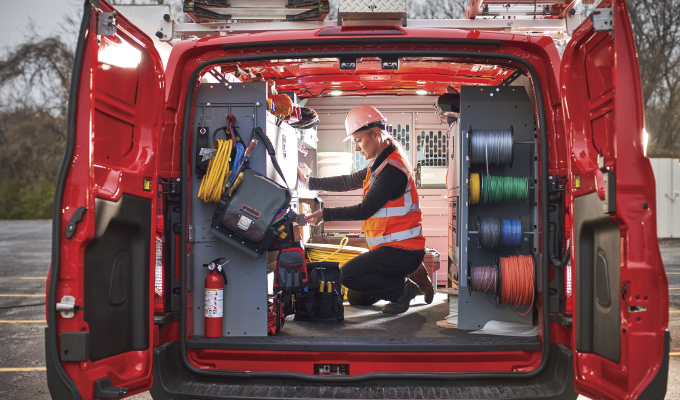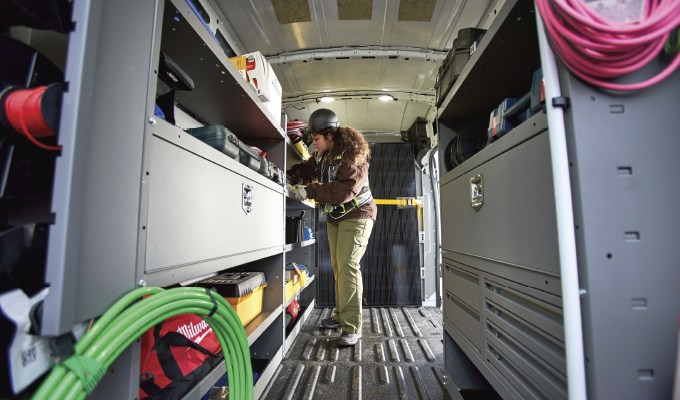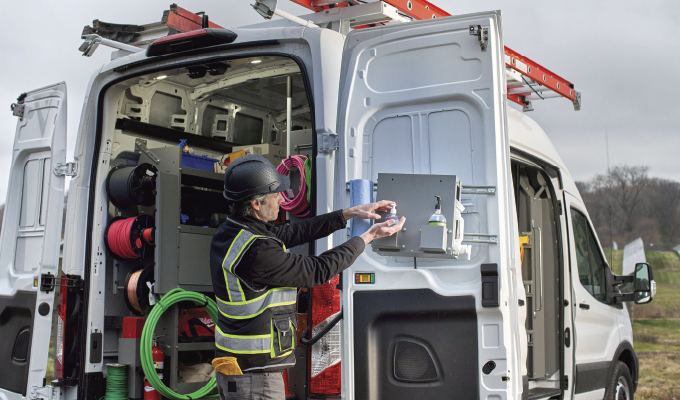The commercial van segment is perhaps the fastest growing in the industry. Whether it is a last-mile delivery van or a highly specialized mobile service unit, fleet operators continue to find new, innovative ways to use these versatile vehicles.
While commercial vans offer a virtual blank canvas for customization, you need a strong upfit strategy to maximize the potential of these vehicles. To help you craft a comprehensive upfit strategy that transforms commercial vans into the vocational powerhouses, your company needs to keep your business moving forward.
Here are a few key factors to consider.
ENGAGE KEY FLEET STAKEHOLDERS
The importance of understanding the intended job function of each unit and how it supports your business cannot be overstated. The more you know about how your business functions, the better equipped you’ll be to develop an upfit strategy that maximizes the potential of your commercial vans. It is also important to remember that developing upfit specs isn’t just a fleet project; it’s an overall business project.
You’ll benefit greatly by soliciting input from other fleet stakeholders throughout your business, particularly your operations team and frontline employees. Collaboration is key. Spend a day in the field with your employees. Interview operations managers to find out how vehicles are used and if there are opportunities for improvement. Your upfit solutions should complement your driver and their vehicle, not hinder their productivity.
The relationship between the vehicle type, cargo/equipment, driver, intended role, and the work environment is key. Once you understand how these numerous factors influence each other, you can focus on tailoring your upfit package to maximize efficiency and enhance safety. Whether it is the placement of handles, quality partitions, storage options, or ease of accessibility; everything becomes a factor.
Try to be as hands-on as possible and involve your various stakeholders in the process to avoid a potential disconnect between what looks good on paper and how these commercial vans are being used in the field. This insight will ensure your vans are properly spec’d to optimize efficiency and avoid unnecessary expenses.

BUDGETING AND COST CONSIDERATIONS
As vehicle and upfitting costs continue to increase, you’ll want to be proactive in your planning and budget allocation. We often advise our customers to embrace a macro approach. Rather than simply planning for the year ahead, if you’re able to forecast three to five years out, you’ll have greater financial flexibility to adjust to unforeseen challenges or have capital available to take advantage of cost-savings opportunities that may arise.
You’ll also want to be sure to avoid basing your upfit strategy purely on up-front costs. While you may be able to reduce upfitting costs at the time of acquisition, you’ll likely experience significantly higher operating costs and reduced productivity throughout the van’s time in service. Frequently, units end up being under spec’d for their intended job function leading to safety risks, increased maintenance costs, unforeseen downtime, shorter lifecycles, and reduced resale value. These under spec’d vehicles often require additional upfitting after they are in service, which tends to be lower quality and much more costly. Instead, assess the projected total cost of ownership over the entire lifecycle of the vehicle.
PROACTIVE PLANNING
Be sure to have a proactive strategy in place for developing vehicle and upfit specifications. Take your time and be thoughtful in your execution. Proper planning helps to ensure a quality specification which, in turn, helps to improve the lifecycle of your commercial vans.
Without an effective, proactive strategy, you may find yourself purchasing units from dealer stock (rather than factory orders), driving costs higher and/or potentially delaying delivery, which can hamper productivity. Additionally, without a proactive approach, you may not be able to acquire units with the proper upfitting in a timely manner which can result in a wide range of operational challenges for your frontline employees.
The first thing you need to determine is when new vehicles need to arrive in the field. Then, based on your replacement cycles, when do you need to begin your planning and ordering process to ensure enough lead time to get new units on the road as current vehicles approach the end of their lifecycle. While each scenario will vary, fleet operators should allow generous lead time for new units, potentially as much as 10 months for complex builds.
This is where seamless collaboration and simplified communication across your entire supply chain becomes even more critical. You, your fleet management provider, and upfit partner need to be aligned on OEM production schedules, upfitter production capacity, delivery scenarios, target in-service dates, etc.
THOROUGH YET MANAGEABLE CATALOG
While it is critical that you prioritize upfitting each van for its intended function, you also want to maintain a reasonable number of specs for your fleet. Ideally, you don’t want an overwhelming library of upfit specs to manage and further complicate your acquisition process.
This standardization can also make the vans more cost effective by eliminating unnecessary upfitting. Additionally, if you’re able to limit the number of upfit solutions in your catalog, you’ll have greater flexibility to shuffle your vans across your fleet to areas or roles where the vehicle is needed most. This streamlining also benefits you when it comes time to sell the unit. With an upfit package that’s useful across numerous applications, the unit will appeal to more potential buyers, maximizing resale value and reducing your total cost of ownership.
IMPORTANCE OF COMPONENT QUALITY
For vocational fleets, your vehicles are essential tools that support your business’ daily operations. Typically, uptime and reliability are paramount. With that in mind, you want to be sure to install quality components – storage racks, partitions, flooring, and equipment – that can withstand the rigors of heavy commercial use.
You’ll also want to consider the material used for the various components. Steel and aluminum are the most common and there are distinct benefits to each. Composite materials are also becoming increasingly popular. Upfit solutions such as Holman’s recently introduced rigid van flooring leverage composite materials that are non-slip and impact resistant.
REMAIN FLEXIBLE AND AGILE
Even with proper planning, there are inevitably going to be times when you may need to acquire a new van quickly. When time is off the essence, you’ll need to remain flexible and adapt your upfit strategy for these unforeseen scenarios.
If you find yourself purchasing a commercial van from a dealer’s stock inventory, you will still need to customize it for the specific role it will play in your fleet. In this scenario, you likely won’t be able to leverage your typical upfit strategy. Instead, you can opt for an off-the-shelf solution that gets your new van on the road and in service as quickly as possible. For example, Holman offers several quick package solutions that feature a variety of configurations for many popular van models that can be installed by regional upfitters in as little as three days.

ALIGN WITH STRONG PARTNERS THROUGHOUT THE SUPPLY CHAIN
Key to any successful upfit strategy is collaborative partnerships across that supply chain. Typically, a multi-year relationship with a fleet management provider and upfit partner is extremely beneficial for most fleet operators, bringing continuity to the entire process.
Working closely with your fleet management and upfit partners and maintaining an open dialogue helps to ensure everyone is aligned on your fleet and overall business strategy. Additionally, these strategic partnerships provide greater visibility into precisely how a particular vehicle is being used in the field, allowing you to collaborate and pivot accordingly if there’s a change that may impact your upfit buildout. If you find yourself in a cycle of constant change, always looking for the fastest or cheapest option, you’ll likely experience a greater number of disruptions that will certainly impact your fleet stakeholders.
Also, be sure to keep in mind, when it comes to selecting an upfit partner, you’ll benefit greatly by doing your homework ahead of time.
Consult your fleet management provider. Network with your peers from across the industry to understand why they partner with a particular upfitter. Visit upfitters in person to get a better sense of their facilities and their culture. You’ll want to ensure the upfitter’s capabilities align with the needs of your organization. If you have a complex van buildout, does your upfitter have the core competencies and engineering expertise to properly produce those units? If you have a decentralized fleet with a national footprint, an upfit partner with the ability to accommodate multiple delivery options (ship-thru, drop-ship, regional builds) can help minimize delivery and licensing costs.
Most importantly, remember, there isn’t a one-size-fits-all solution when it comes to developing an effective upfit strategy for versatile commercial vans. While the factors above are certainly important to consider, you’ll want to develop an upfit strategy based on what’s most critical to the success of your business.
About the Author
Bryan Schieler is the director, operations engineering at Holman. www.holman.com




